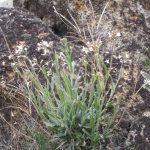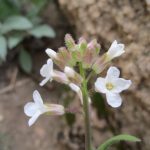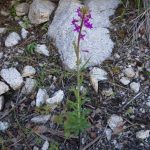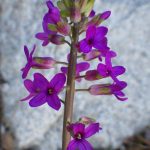Hairystem rockcress is easily confused with the pale-flowered extreme of sicklepod rockcress (Boechera sparsiflora) but can be distinguished by the diagnostic features summarized under the latter species. The two species are probably conflated in Bjornsen’s description of Arabis hirsuta in her 1946 flora: “It is found in rocky places blooming in March and April. The specimens we have seen have white petals and sepals, the latter with a bit of lavender color added.”
Species Page
Boechera retrofracta
Secund rockcress is our common local Boechera that has sharply reflexed pedicels at maturity, with the slender fruit usually hanging on one side (secund). It is most frequently encountered in the Conifer Zone. The species was previously encompassed in a broadly defined Arabis holboelii, but both the genus and species have been split into finer units.
Boechera sparsiflora
Sicklepod rockcress occurs sporadically in the hills throughout the Boise Front, mostly below the conifer zone. It resembles hairy-stem rockcress (Boechera pauciflora), which is the other local species with arched (vs. sharply reflexed) fruit, but differ primarily in the these features:
1a. Hairs unbranched at least on pedicel, and usually dense at base of stem; hairs branched on basal leaves (where looser and more obviously stalked than in B. pauciflora, with many at least ½ mm long); fruits usually ascending. . . B. sparsiflora (sicklepod rockcress)
1b. Hairs branched throughout (including pedicel);hairs dense and +/- sessile at least on basal leaves (where generally ¼ mm or less total length); fruits most often arching downward . . . B. pauciflora (hairy-stem rockcress)
Encompassed within the current circumscription of Boechera sparsiflora are two morphological extremes. The more widespread extreme generally has multiple stems that are 2–3(–4) dm tall, topped by flowers that are white to light purple; these plants are the ones most easily confused with B. pauciflora. The other morphological extreme often has only a single stem that can be at 8 dm tall, topped by relatively large, deep violet flowers. This extreme occurs from at least Eagle to Pocatello. Intermediates exist, but it is quite possible that further research will result in recognizing these two extremes as different varieties, if not different species.
The genus Boechera was previously included in Arabis, but most North American species are now treated as this separate genus. There are still some North American species included in the otherwise Eurasian genus Arabis, but none occur in the Boise Front.
Bjornsen’s spring flora (1946) refers to the violet form as Arabis perelegans, noting that “It has conspicuous flowers; is leafy up to the raceme; the lower leaves are petioled but gradually there is a change to narrower leaves partially clasping the stem towards the top of the stem.” However, the type of Arabis perelegans from Yellowstone National Park, which determines the application of the name, is currently included in the synonymy of Boechera pauciflora, presumably based on the abundance of branched hairs. In contrast, the type of Arabis arcoidea from New Plymouth, which has “petals purplish to violet”, is currently included in the synonymy of B. sparsiflora and could easily be the same thing as the violet extreme in the Boise Front.



